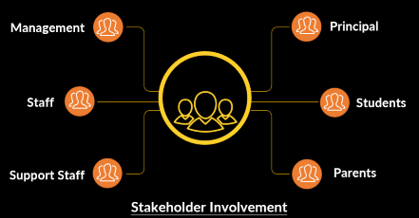
Ensuring the safety of students in schools is a collective responsibility that requires the active involvement of various stakeholders. From the management and principal to staff, students, parents, drivers, maids, and cleaning staff, each stakeholder within the school ecosystem plays a vital role in creating a secure learning environment. Let’s explore how their collaborative efforts contribute to school safety in India.
Stakeholders in the School Ecosystem:
Management: Providing a Foundation for Safety:
The management of a school sets the tone for safety by establishing policies, allocating resources, and promoting a safety-oriented culture. They should ensure compliance with safety regulations, conduct regular 3rd party safety audits & internal audits, and prioritize infrastructure maintenance. The management should also facilitate the implementation of training programs, collaborate with parents, and support initiatives that enhance overall school safety.
Principal: Leadership in Safety:
The principal serves as a key leader in promoting safety within the school. They play a crucial role in developing and implementing safety protocols, organizing safety drills, and ensuring staff members are trained in emergency response. The principal also fosters a positive school climate, encourages open communication, and addresses safety concerns promptly. By providing guidance and support, they create an environment where safety is a top priority.
Staff: Vigilance and Preparedness:
Teachers and staff members are at the forefront of ensuring day-to-day safety in schools. They need to maintain a vigilant presence, identify and address potential hazards, and respond promptly to safety concerns. Staff members should be trained in first aid, CPR, and emergency response protocols. They should actively participate in safety drills, supervise students during recess and other activities, and promote safe behavior among students. Staff collaboration with parents and students fosters a strong safety network within the school community.
Students: Active Participants in Safety:
Students have an important role to play in their own safety and the safety of their peers. They should be encouraged to follow safety rules, report concerns to teachers or staff, and actively participate in safety drills. Students can contribute by being respectful, responsible, and mindful of their actions, thereby creating a safe and inclusive environment. Anti-bullying initiatives empower students to stand up against bullying and ensure the emotional well-being of their classmates. Each safety aspect that students learn within the school environment is something they carry back home, with the hope of inspiring their parents and relatives to embrace those practices.
Parents: Collaboration and Communication:
Parents are integral stakeholders in school safety. They collaborate with school management and staff, attending safety meetings and workshops. Parents are encouraged to communicate any safety concerns promptly and maintain open lines of communication with teachers and school authorities. They play an active role in educating their children about personal safety, cyber safety, and responsible behavior. Parents also support and reinforce safety practices at home, ensuring a holistic approach to student safety.
Drivers, Maids & Cleaning Staff: Ensuring Secure Environments:
Drivers, maids, and cleaning staff are crucial in maintaining a safe and secure environment. Drivers should adhere to traffic rules, possess valid licenses, and receive training in safe driving practices. Maids contribute to student safety by monitoring students during breaks and ensuring their well-being. Cleaning staff play a role in maintaining cleanliness and hygiene, preventing accidents caused by slippery surfaces or unsanitary conditions. Their active involvement enhances the overall safety and well-being of students.
Safety in schools in India requires the collective efforts of multiple stakeholders. From the management’s commitment to safety protocols to the principal’s leadership, staff’s vigilance, students’ active participation, and parents’ collaboration, a strong safety network is built. Additionally, the involvement of third-party safety auditors and trainers brings valuable expertise, unbiased assessments, and specialized training, ensuring that schools maintain the highest standards of safety for the well-being of every child.
JUN
2023
